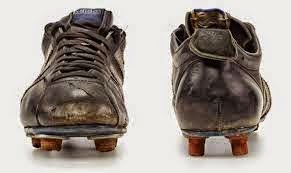England's King
Henry VIII wardrobe discovered the first soccer cleats which were made by the
King's personal shoemaker Cornelius Johnson in 1525.Their cost was 4 shillings
at that time and the same cleats cost around 100$ now. The first cleats which
were made were of ankle high and made of strong leather which was heavier than
other shoes which people used to wear.
During
1800’s:-
Between 1500’s
and 1800’s Football had become very popular in Great Britain which was not
structured and which was not having any particular rules. Hence, it was played
in a rough manner. Most of the games ended up with players bleeding and having
broken bones to players. They used to wear
their hard, leather, long laced work boots that were ankle high with a steel
toe-cap. To have more grip on ground, villagers
hammered metal tacks or studs on the bottom of their shoes during this time
period. Soccer cleats shifted towards creating better designed and more
comfortable style of cleats. Soccer boots weighted 500 grams
and were made of hard and thick leather that went up the ankle for increased
protection. These soccer cleats had 6 studs on the bottom of each shoe and
during rainy weather soccer shoes would increase more than double in weight
making them really heavy for the players wearing them.
Between 1900’s
to 1940’s:-
The shoes
remained the same and there was quite improvements in shoes, there was business
started by the companies and the manufacturers of them. Gola (1905), Valsport (1920), Hummel
(1923) were some of the companies that got started manufacturing soccer cleats
during early 1900's. An interesting fact is that, two
German brothers Adolf and Rudolf formed the Gebrüder Dassler Schuhfabrik
(Dassler Brothers Shoe Factory) in Herzogenaurach during 1924. They started
producing soccer cleats in 1925 which had 6 or 7 replaceable studs. The studs
could be changed according to the weather conditions and situations of the
game. These were the first soccer shoes made with replaceable studs
During 1940’s to 1960’s:-
It was during
this time that more flexible, comfortable and much lighter soccer cleats
started to be made by new companies. World Cup was gaining popularity. Soccer
boot production completely changed towards producing a lighter soccer cleats
with the focus on kicking and controlling the soccer ball other than simply
producing protective footwear to play. World recognized soccer cleats company
Adidas and Puma were also formed during this time after the falling out between
the two German brothers Adolf and Rudolf who had formed "Dassler Brothers
Shoe Factory" in 1924. Adolf separated from his brother
in the early 1940's staying in the original factory and renaming the company to
"Adidas" while Rudolf went across river and created his own shoe
factory, naming it "PUMA" in 1948. After opening new PUMA shoe
factory, Rudolf produced Puma Atom soccer cleats. Puma was the first company to
produce soccer cleats with interchangeable screw in studs made of plastic or
rubber for the first time. Soccer cleats between 1940 and
1960 were still produced in over the ankle design since past. Cleats of this
time were improved by using synthetic materials and leather.
During 1960’s
to 1970’s:-
The change in
design that the lower cut design instead of ankle high design was introduced
for the first time in soccer history. That lower cut design allowed quick
players to take full advantage of having free ankles to move faster on the
field. Soccer legend Pele was one of many other players that wore PUMA soccer
cleats during the 1962 FIFA World Cup. Adidas quickly emerged as the market
leader with 75% of players in 1966 World Cup having Adidas soccer cleats. Mitre
in 1960, Asics in 1964 and Joma in 1965 were also made during those years as
competition for them.
During 1970’s
to 1980’s:-
Pele lifted
the 1970 FIFA World Cup trophy wearing Puma King Soccer cleats. During the
1970's sponsorship, where players got money to wear only one brand when playing
.They improved by producing lighter cleats made out of synthetic and leather
with improved design to help with the traction on the grass. Adidas produced the world's best selling
soccer cleats "Copa Mundial" in 1979. Cleats are built out of
kangaroo leather for speed and versatility and they are still used today. Italian
famous soccer boot maker "Diadora" in 1977 popped up.
During 1980’s
to 1990’s:-
All
manufacturing companies produced lighter, new design soccer cleats during this
time improving on stud placement and the overall performance of the boot. Craig Johnston got a change to the
soccer boots during the 1980's as he created the Predator soccer cleats during
the 1990's, those Predator's were released by Adidas in the early 1990's.They
had much improved traction between the ball and soccer boot and soccer boot and
the ground. LOTTO started making
soccer cleats in 1982. KELME started making soccer cleats in 1982. UMBRO
started making soccer cleats in 1985.
During 1990’s to 2000’s:-
After designing his new model for many years Johnston
During 2000’s
to until now:-
The
application of new research is applied in creating new and improved soccer
cleats. Top three soccer cleat makers and sellers: Puma, Adidas and Nike
reinforced their position as the top soccer cleat makers and sellers. There are
still other smaller soccer boot producers such are Mizuno, Diadora, Lotto,
Hummel and Nomis. As the time passes many new soccer cleats are made with
improvement constantly being added.
 |
| 1960s |
 |
| 1990s |
 |
| 2000s till now |
 |
| 1900s |
 |
| 1900s |
 |
| 1970s |
 |
| 1980s #Entertainament #9D |












No comments